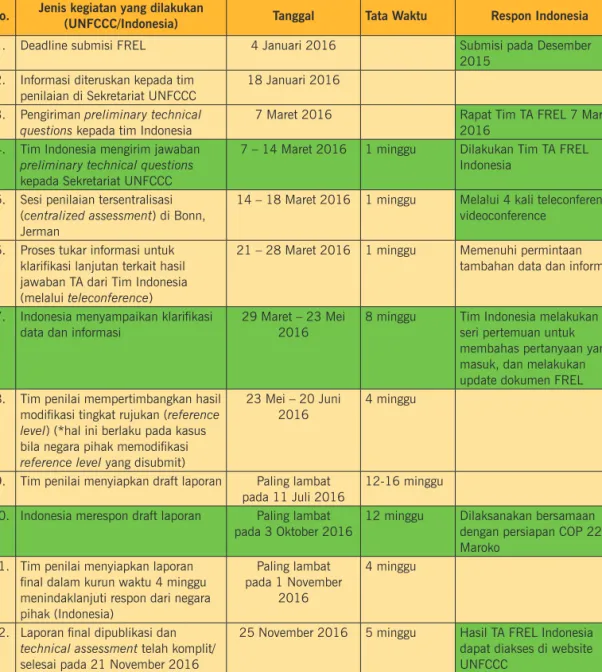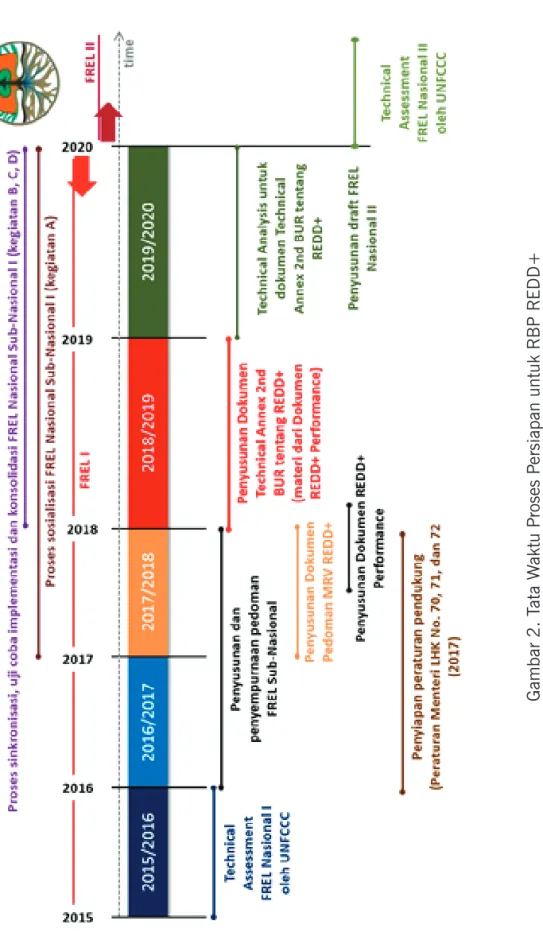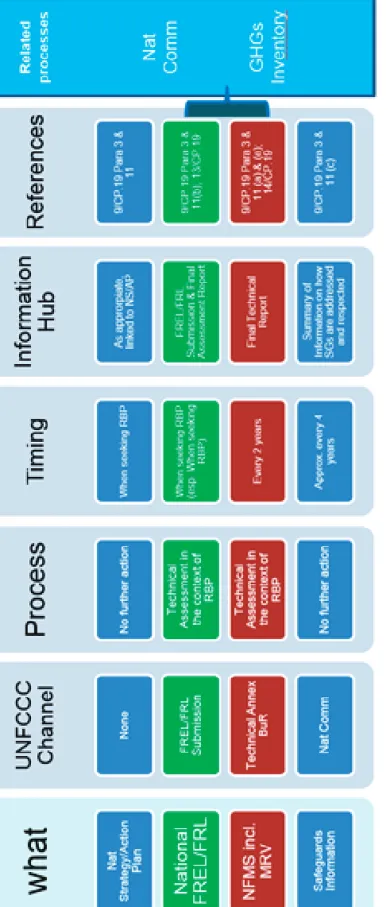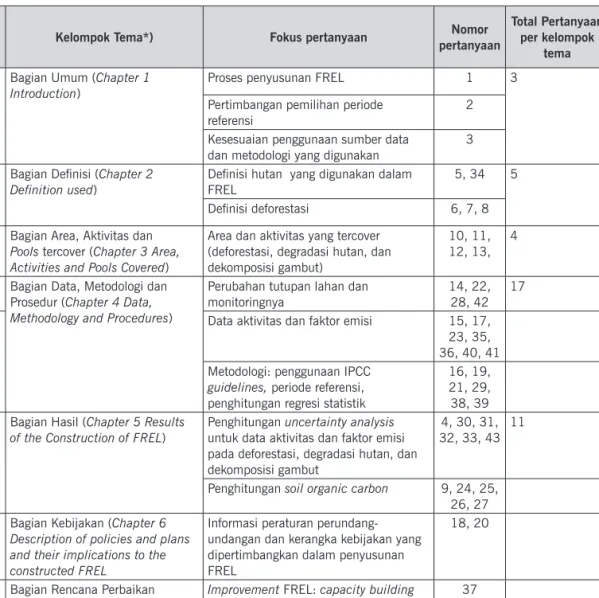Sebagai bagian dari prasyarat untuk Pembayaran Berbasis Hasil (RBP), FREL Negara Pihak yang diajukan kemudian dinilai secara teknis dalam proses penilaian teknis FREL yang dilakukan oleh Sekretariat UNFCCC. Dengan selesainya proses penilaian teknis FREL, ini menandakan bahwa Indonesia siap menggunakan FREL-nya sebagai tolok ukur untuk mengukur kinerja di sektor kehutanan, khususnya pengukuran penurunan emisi REDD+. Kami mengucapkan terima kasih kepada berbagai pihak yang telah berkontribusi dalam proses asesmen teknis FREL tahun 2016 dan proses penyusunan buku ini, khususnya yang tergabung dalam tim asesmen teknis FREL Indonesia, akademisi dan pembuat kebijakan yang berkontribusi dalam pelaksanaan RDEČ +.
Pembentukan Tim Asistensi Teknis Kajian Teknis Tingkat Emisi Referensi Hutan di Indonesia 25 Lampiran 2. Forest Reference Emission Level (FREL) adalah tingkat referensi emisi hutan yang menjadi acuan atau tolak ukur suatu negara atau wilayah tertentu untuk mengukur sektor kehutanan kinerja terkait langkah-langkah mitigasi pengurangan emisi dalam skema Pengurangan emisi dari deforestasi dan degradasi hutan Plus (REDD+). Indonesia menjalani proses TA atas dokumen FREL selama 10 bulan pada tahun 2016 dan lulus dengan diterbitkannya technical assessment report oleh Sekretariat UNFCCC.
Tujuan
Sasaran
TECHNICAL ASSESSMENT FREL DALAM
PERKEMBANGAN NEGOSIASI DI COP UNFCCC
PELAKSANAAN TECHNICAL ASSESSMENT FREL INDONESIA
Tim TA FREL Indonesia bekerja sesuai dengan kerangka waktu pelaksanaan TA FREL yang telah ditetapkan oleh Sekretariat UNFCCC. Tim TA FREL Indonesia kemudian melakukan diskusi kelompok terarah untuk menjawab pertanyaan-pertanyaan tersebut. Sekretariat UNFCCC bersama Tim TA UNFCCC menyiapkan laporan penilaian awal yang dikomunikasikan kepada Tim TA FREL Indonesia pada tanggal 28 Maret 2016.
Selama jangka waktu penyusunan laporan penilaian awal, tim TA UNFCCC dan tim TA FREL Indonesia mengadakan telekonferensi untuk membahas rincian semua tanggapan. Tim TA UNFCCC meminta klarifikasi langsung dari tim FREL TA Indonesia terkait data dan informasi yang diberikan. Tim TA UNFCCC menindaklanjutinya dengan mengirimkan pertanyaan tambahan (Pertanyaan No. 43) kepada tim TA FREL Indonesia pada tanggal 10 April 2016 waktu Bonn.

PENUTUP
Dengan diadopsinya FREL Indonesia sebagai dasar pengukuran kinerja REDD+ di Indonesia yang diakui secara nasional dan internasional, Indonesia secara resmi telah memasuki tahap implementasi REDD+. Diharapkan Buku Proses Penilaian Teknis Tingkat Rujukan Emisi Hutan Indonesia (2016) ini dapat menjadi acuan dalam pelaksanaan TA dan pelaksanaan REDD+ di Indonesia pada umumnya, serta pembelajaran bagi pihak-pihak terkait dan dapat menjadi dokumentasi penting dalam pelaksanaan REDD+ dari tahap persiapan hingga tahap implementasi di Indonesia. Sedangkan pengajuan acuan tingkat emisi hutan dari negara anggota UNFCCC Convention on Climate Change (COP) akan dilakukan evaluasi teknis oleh Sekretariat UNFCCC selama 1 tahun.
PERTAMA : Tim Asistensi Teknis Kajian Teknis Tingkat Emisi Rujukan Hutan (FREL) di Indonesia terdiri dari Tim Pengelola dan Tim Teknis sebagaimana tercantum dalam lampiran keputusan ini; KETIGA : Dalam menjalankan tugasnya, Tim Pengarah dan Tim Asistensi Teknis penilaian teknis FREL di Indonesia bertanggung jawab kepada Direktur Jenderal Pengendalian Perubahan Iklim. TENTANG : Penunjukan Tim Asistensi Teknis Kajian Teknis Tingkat Emisi Rujukan Hutan di Indonesia.

Sekretariat
Margono Kasubdit Monitoring Pelaporan Verifikasi dan Daftar Aksi Mitigasi Bidang Berbasis Lahan, Direktorat IGRK-MPV.
Kelengkapan Data Spasial dan Attribut terkait
Kelengkapan Data Biomass dan Data non-spasial terkait 29. Ubaidillah Salabi Kepala Sub Direktorat Inventarisasi Sumber Daya
Kelengkapan Data dan Informasi khusus Gambut 33. Wayan Susi
The differences between the three initiatives are the reference period, the activity data (deforestation data) and the emission factors used in constructing the FREL/Baseline emission. Information on SE has been added to revised Table 2 in the updated FREL document. While the definition of the Ministry of Forces in the same paragraph says "Ministry of Forests No.
This is one of the areas for improvement in the next FREL layout (see section 7.5). Could you please clarify which version of the IPCC guidelines was used in the submission. As detailed in Appendix 1, the land cover (LC) data is a series (T1 to Tx), and we generated the degraded forest by comparing the LC of T1 (primary forest class) with the LC of T2 (being class of secondary forests).
We were now able to match some of the emission factors in Appendix 6 with the factors given in Table 2.1 in the Wetlands Supplement. Information that was used by the Party in the construction of the forest emission reference level. Transparency, completeness, consistency and accuracy of the information used in the construction of the forest reference.
Please also see sub-chapter 4.1.1., and additional text on Appendix 1.1., in the final FREL document. According to the AT, improving quality management is an area of technical improvement. 18 Emission factors used in the FREL for deforestation and forest degradation are based on data collected in Indonesia's national forest inventory.
Adding more text about the purpose of FREL submission and BUR submission in the final FREL document. The reasons for not including the pools in the submission have been explained in the FREL document. AT agrees with Indonesia's assessment and commends Indonesia for the ongoing work in the following areas for improvement:.
Report on the technical assessment of the proposed forest reference emission level of Indonesia submitted in 2016
Introduction and summary A. Overview
This report covers the Technical Assessment (TA) of Indonesia's submission on the proposed Forest Emission Reference Level (FREL)1 submitted on 4 January 2016 pursuant to decisions 12/CP.17 and 13/CP.19. The technical assistance took place (as a centralized activity) from 17 to 18 March 2016 in Bonn, Germany, and was coordinated by the secretariat.2 The technical assistance was carried out by two experts in land use, land use change and forestry (LULUCF) from the List of Experts3 UNFCCC (hereinafter the Assessment Team (AT)): Mr. Kamel Djemouai, an expert from the Consultative Group of Experts on National Communications of Parties not included in Annex I to the Convention, participated as an observer4 during the centralized activity in Bonn.
In response to the invitation by the Conference of the Parties (COP) and in accordance with the provisions of decision 12/CP.17, paragraphs 7–15, and its annex, Indonesia submitted its proposed FREL on a voluntary basis. This proposed FREL is one of the elements5 to be developed in the implementation of the activities referred to in decision 1/CP.16, paragraph 70. The COP decided that each submission of a proposed FREL or forest reference level (FRL), as referred to in decision 12/CP.17, paragraph 13, will be subject to a TA in the context of results-based payments, in accordance with decision 13/CP.19, paragraphs 1 and 2, and decision 14/CP.19, paragraphs 7 and 8.
The objective of this TA was to assess the extent to which the information provided by Indonesia was consistent with the guidelines for reporting information on FRELs and FRLs6 and to provide a facilitative tool. The FREL TA submitted by Indonesia was undertaken in accordance with the guidelines and procedures for the TA of submissions by Parties on proposed FRELs and FRLs as contained in the annex to decision 13/CP.19. This report for the TA was prepared by the TA according to the instructions and procedures in the same decision.
Following the process contained in the guidelines and procedures of the same decision, a draft version of this report was communicated to the Government of Indonesia. The facilitative exchange during the TA allowed Indonesia to provide clarifications and information that was considered by the TA in the preparation of this report.8 As a result of the facilitative interactions with the TA during the TA session, Indonesia has an amended version submitted on 13 May 2016, which took into account the technical input by the AT. The amendments improved the clarity and transparency of the submitted FREL, without the need to change the approach used to construct the originally proposed FREL.
The amended submission containing the estimated FREL and the original submission are available on the UNFCCC website.9.
Proposed forest reference emission level
- Data, methodologies and procedures used in the construction of the proposed forest reference emission level How each element in the annex to decision 12/
- Information that was used by the Party in the construction of the forest reference emission level
- Transparency, completeness, consistency and accuracy of the information used in the construction of the forest reference emission level
- Pools, gases and activities included in the construction of the forest refer- ence emission level
- Definition of forest
- Conclusions
Information used by the Party in the construction of the forest reference emission level reference emission level. The peatland spatial data used in the construction of the FREL was provided by the Ministry of Agriculture, and was based on various related maps, field surveys and soil investigations. Emission factors used in the FREL for deforestation and forest degradation are based on data from Indonesia's NFI.
AT noted that while the emission factors from the wetlands supplement are only intended to be applied to "drained organic soils," FREL does not differentiate between areas with and without drainage. AT commends Indonesia for establishing overall consistency between the data sources between FREL and the national greenhouse gas (GHG) inventory contained in BUR. AT notes that FREL uses a different forest definition than that used in the national greenhouse gas inventory contained in Indonesia's first.
AT commends Indonesia for including an explanation of the forest definition in the amended FREL submission. Pools, gases and activities included in the construction of the forest reference emission level ence emission level. The activities included in FREL, which are likely to be the REDD-plus activities with the most significant emissions in Indonesia, are: reduction of emissions from deforestation and from forest degradation.
The definition of forest in FREL's submission is slightly different from that used in Indonesia's National Greenhouse Gas Inventory for its first BUR. AT acknowledges that Indonesia has included in FREL emissions from deforestation and forest degradation, which are the two most important REDD-plus activities in Indonesia. AT commends Indonesia for providing information on its ongoing work to develop FREL and improve the accuracy and coverage of estimates.
The FREL and the National Greenhouse Gas Inventory in Indonesia's First Biennial Update Report both use the same key data sources.

